

The Rime of the Ancient Mariner. Samuel Taylor Coleridge (born October 1772) is most famous for his poem The Rime of the Ancient Mariner, which was first published in 1798 in Lyrical Ballads, a collection he co-wrote with William Wordsworth.

Lyrical Ballads is considered one of the major texts of Romantic poetry. Poe's Tales of Mystery & Imagination, illustrated by Arthur Rackham. Published in London in 1935, Tales of Mystery and Imagination contains short stories by American author Edgar Allan Poe (1809–1849) with illustrations by Arthur Rackham (1867–1939).

Today Poe’s name is synonymous with Gothic literature and his influence on British Gothic is profound. Poe, who spent some of his formative years in Britain, borrowed figures such as the debauched nobleman and the mysterious doppelgänger, or ‘evil twin’, from earlier Gothic tales and then wove them into stories uniquely his own. It is in these tales that Gothic fiction gains psychological tension. Poe’s uncanny and macabre work harks back to that of Ann Radcliffe and Matthew Lewis while simultaneously providing inspiration for the authors who followed including Robert Louis Stevenson and Oscar Wilde. Poe’s influence continued into the 20th century. ‘The Oval Portrait’ (1842), shown here, is a fine example of how Poe took ideas from earlier Gothic tales and gave them a new twist. An introduction to The Rime of the Ancient Mariner. Dr Seamus Perry describes the origins of The Rime of the Ancient Mariner and considers how Coleridge uses the poem to explore ideas of sin, suffering and salvation.

A failed collaboration In the Autumn of 1797, Coleridge was nearby William Wordsworth and his sister Dorothy, in north Somerset; and, despite his wife and young child, he spent as much time as he could with the Wordsworths. Both men, still in their 20s, were published poets, though neither had achieved anything approaching commercial success and money was tight; so, when the three of them decided to go off on a walking tour across the Quantock Hills towards the sea they had to think about funds. The Picture of Dorian Gray: art, ethics and the artist. Dark desires and forbidden pleasure are at the centre of The Picture of Dorian Gray.
Greg Buzwell examines the interplay between art and morality in Oscar Wilde’s novel, and considers its use of traditional Gothic motifs as well as the theories of the new aesthetic movement. Oscar Wilde’s only novel, The Picture of Dorian Gray (1891), is a superb example of late-Victorian Gothic fiction. It ranks alongside Robert Louis Stevenson’s Strange Case of Dr Jekyll and Mr Hyde (1886) and Bram Stoker’s Dracula (1897) as a representation of how fin-de-siècle literature explored the darkest recesses of Victorian society and the often disturbing private desires that lurked behind acceptable public faces. Dracula: the Victorian vampire. The vampire is a complicated creature: caught between life and death, at once alluring and horrifying.
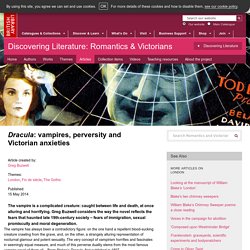
Greg Buzwell considers the way the novel reflects the fears that haunted late 19th-century society – fears of immigration, sexual promiscuity and moral degeneration. The vampire has always been a contradictory figure: on the one hand a repellent blood-sucking creature crawling from the grave, and, on the other, a strangely alluring representation of nocturnal glamour and potent sexuality. The very concept of vampirism horrifies and fascinates in seemingly equal measure, and much of this perverse duality stems from the most famous vampire novel of them all – Bram Stoker’s Dracula, first published in 1897. First edition of Dracula Front cover to the first edition of Bram Stoker’s novel Dracula, 1897. View images from this item (1) ‘Man is not truly one, but truly two’: duality in Robert Louis Stevenson’s Strange Case of Dr Jekyll and Mr Hyde.
Curator Greg Buzwell considers duality in Strange Case of Dr Jekyll and Mr Hyde, exploring how the novel engages with contemporary debates about evolution, degeneration, consciousness, homosexuality and criminal psychology. Robert Louis Stevenson’s The Strange Case of Dr Jekyll and Mr Hyde (1886) is a late-Victorian variation on ideas first raised in Mary Shelley’s Frankenstein (1818). Landscape and the Sublime. Gothic Readings by Rictor Norton. Edited by Rictor Norton (London and New York: Leicester University Press, 2000)
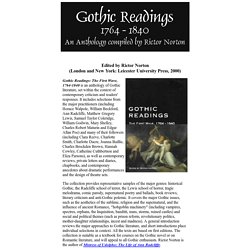
The Cambridge Guide to Gothic Literature. A Brief Historical Overview. The Bloody Chamber. Frankenstein. A brief history of goths - Dan Adams. Examining the developments of the “goths” and “gothic” provides a way to explore the major artistic movements in Western history.

Start with the Classical Age. Because most primary documents were created by the Romans, they carry a heavy bias against the Goths. Why do we read scary books? Some of my favourite books when I was 13 or so were horror stories.
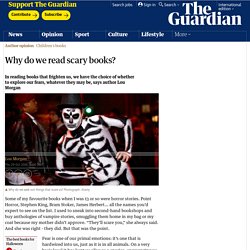
Point Horror, Stephen King, Bram Stoker, James Herbert… all the names you’d expect to see on the list. I used to sneak into second-hand bookshops and buy anthologies of vampire stories, smuggling them home in my bag or my coat because my mother didn’t approve. “They’ll scare you,” she always said. And she was right - they did. But that was the point. Fear is one of our primal emotions: it’s one that is hardwired into us, just as it is in all animals. We’re a peculiar lot, when you think about it: we work so hard to make our world, our environment safer… and then we actively seek out things that will make us afraid. When I asked my corner of Twitter what scared them (in a very quick and - admittedly - deeply unscientific survey), I got answers ranging from “human cruelty” to “being insignificant”. Simple. There is always space for us at the middle of a story - any story. We’re curious about fear. GOTHIC.
Reading To Write: Gothic Worlds. Gothic motifs. What does it mean to say a text is Gothic?
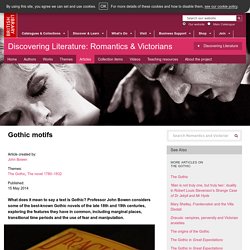
Professor John Bowen considers some of the best-known Gothic novels of the late 18th and 19th centuries, exploring the features they have in common, including marginal places, transitional time periods and the use of fear and manipulation. Professor John Bowen discusses key motifs in Gothic novels , including the uncanny, the sublime and the supernatural.
Filmed at Strawberry Hill House, Twickenham. Gothic is a literary genre, and a characteristically modern one. The word ‘genre’ comes from the Latin ‘genus’ which means ‘kind’. Strange places It is usual for characters in Gothic fiction to find themselves in a strange place; somewhere other, different, mysterious. Front cover for 1919 edition of Dracula Castle Dracula from the cover of the thirteenth edition of Bram Stoker’s Dracula, 1919. View images from this item (1) Great Expectations illustrated by John McLenan View images from this item (16) How to tell you're reading a gothic novel – in pictures. Conventions of the Gothic Genre. There are a number of techniques, devices and conventions common to a great deal of Gothic literature: WEATHER: used in a number of ways and forms, some of these being: Mist - This convention in Gothic Literature is often used to obscure objects (this can be related to the sublime) by reducing visibility or to prelude the insertion of a terrifying person or thing; Storms - These frequently accompany important events.

iWonder - Spine-chillers and suspense: A timeline of Gothic fiction. Elements of the Gothic Novel. Robert Harris Version Date: June 15, 2015 The gothic novel was invented almost single-handedly by Horace Walpole, whose The Castle of Otranto (1764) contains essentially all the elements that constitute the genre.
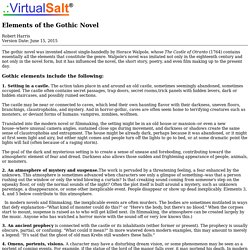
Walpole's novel was imitated not only in the eighteenth century and not only in the novel form, but it has influenced the novel, the short story, poetry, and even film making up to the present day. Gothic elements include the following: 1. Setting in a castle. The castle may be near or connected to caves, which lend their own haunting flavor with their darkness, uneven floors, branchings, claustrophobia, and mystery. Translated into the modern novel or filmmaking, the setting might be in an old house or mansion--or even a new house--where unusual camera angles, sustained close ups during movement, and darkness or shadows create the same sense of claustrophobia and entrapment. 2. The Gothic - The British Library.